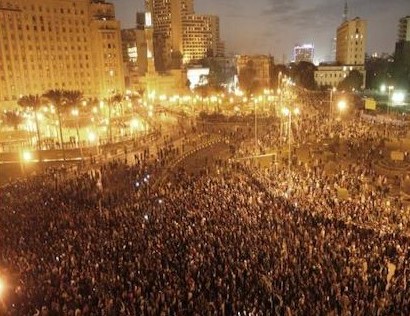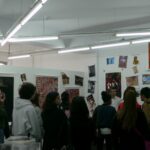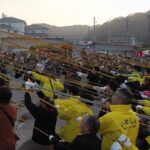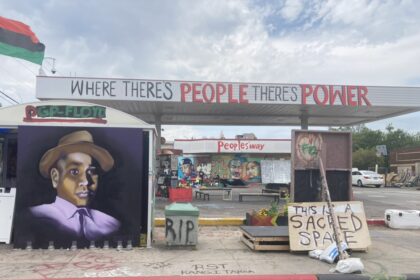Editorial | Winter 2017
Grant Kester
Welcome to issue #6 of FIELD. This issue includes several essays that explore the theme of communism, as both a historically specific mode of political power and as a mythos that might be used to orient ongoing forms of resistance against capitalism. One could argue that we are still, almost thirty years after the fall of the Berlin Wall, coming to terms with the loss of communism as a concrete referent for political transformation. Certainly the broader history of avant-garde art, extending back to the early twentieth-century, has unfolded against the ground of a perceived alternative to bourgeois capitalism, embodied initially by the U.S.S.R. At some points this connection was quite direct, as in Andre Breton’s alliance with Leon Trotsky, Diego Rivera’s vexed relationship with the Mexican Communist Party, or John Heartfield and George Grosz’s (equally vexed) membership in the KPD. In other cases the relationship was more attenuated, as with Adorno’s belief that compositional experimentation in avant-garde art constitutes a decanted form of revolutionary “consciousness”. This connection is so pervasive that it can be difficult for us to fully recognize its implications, not simply at the level of specific formal strategies or institutional affiliations, but in the deeper continuities between the figure of the avant-garde artist and the van guard revolutionary, and the modes of agency, autonomy and political transformation implicit in these subject positions. With the demise of the U.S.S.R., and the transition of China into a mode of state capitalism, the tension between the actuality of communism and its imaginary form, which has constituted the preconscious horizon for several generations of avant-garde artists, has vanished. I would argue that we have yet to fully grasp the impact that this transition has had on the nature of contemporary art.
If history teaches us anything it is that the modality of revolution itself informs the society that emerges in its wake. Given the record of actually existing communism I believe few people are likely to be moved by yet another call for a violent communist revolution that doesn’t also give us some sense of whether the replacement for capitalism will be any better than the system it negates. I also believe that this same question animates a range of artistic practices in the post-’89 period that have experimented with new forms of affinity, solidarity and collective action. These processes are central to the aesthetic quality of new artistic practice, and to a re-configuration of the meaning of the aesthetic itself. But this work, in its often pre-figurative, scalar “modesty,” in its abjuring of rhetorical hyperbole, in its integration with the lives of communities engaged in acts of resistance for which “communist revolution” is an alien and even alienating concept can, easily enough, appear naively reformist. This essential question is taken up in my exchange with Danish art critic and historian Mikkel Bolt Rasmussen. In his essay “A Note on Socially Engaged Art Criticism,” Rasmussen outlines a set of critiques of socially engaged art and art criticism associated with this work, using FIELD as an example. After completing his essay Mikkel sent FIELD a copy and invited us to respond, with the two essays being jointly published in FIELD and the Nordic Journal of Aesthetics (http://nsae.au.dk/). This seemed like an excellent opportunity to open up further dialogue around issues that are clearly central to FIELD. We very much appreciate Mikkel’s generosity in reaching out to us.
This issue also features an essay by FIELD editorial collective member Carlos Garrido Castellano on Hangar: Centro de Investigação Artística, the first artist-run space in Portugal. Hangar is located in the Graça neighborhood of Lisbon, an Afro-Portuguese immigrant community that is facing gentrification. Arts spaces are, of course, often complicit in the gentrification process but Hanger is attempting to resist this tendency by directly engaging the existing community in Graça. The space has developed long-term residencies and exchanges with artists and curators throughout Lusophone Africa (Mozambique, Cape Verde, São Tomé, etc.), who often work in conjunction with neighborhood residents. We are also publishing an interview by FIELD editorial collective member Paloma Checa Gismero with Jorge Fernández Torres. Torres was the director of the 2012 and 2015 iterations of the Bienal de La Habana and is currently Director of the National Museum of Fine Arts in Cuba. In his interview Torres explores the unique role of the Bienal de La Habana as the only global biennial staged in a socialist country, and the complex ways in which Cuba’s unique cultural and social ecology inflects the normative biennial model evident in Venice, Documenta, Gwangju, Sahrja, Berlin, Sydney and elsewhere. Finally, we’re pleased to publish a ”Re-Post” of a fascinating essay by curator Alexander Bortolot on artistic cooperatives in revolutionary Mozambique. The essay reflects on the role of art in Mozambique during the 1960s and ‘70s, as the tourist-oriented traditions of Makonde blackwood carving were re-framed as a form of revolutionary art by the FRELIMO or the Mozambican Liberation Front. This entailed the creation of craft collectives, and a formal re-articulation of Makonde carving traditions towards norms of socialist realism, emphasizing “the strong, well-formed bodies of . . . Mozambicans” as an implicit contrast to the “puny capitalist”. The next two issues of FIELD (#7 and #8) will feature a two-part special issue focus on socially engaged art in Japan, guest-edited by Justin Jesty of the University of Washington. We’d also like to acknowledge the new on-line resource SEACHINA (Socially Engaged Art in Contemporary China), launched by Bo Zheng, FIELD’s Contributing Editor for China. The site includes a digital archive and on-line course materials for a MOOC that introduces researchers to sixteen socially engaged art projects in China. It can be reached at: http://seachina.net/.











